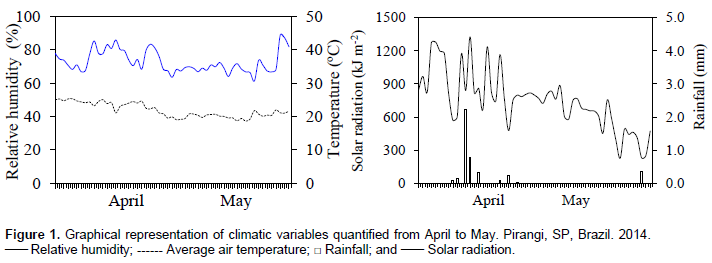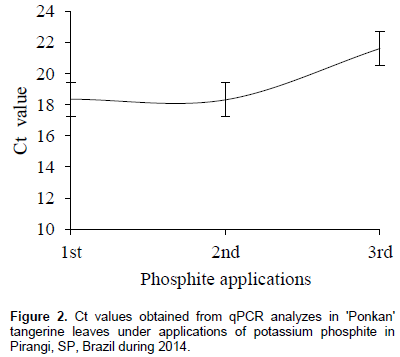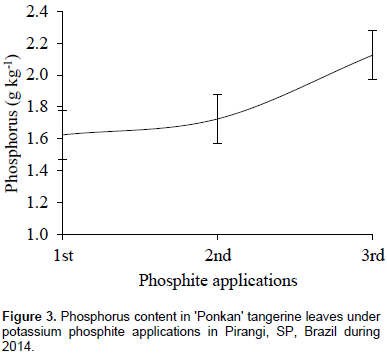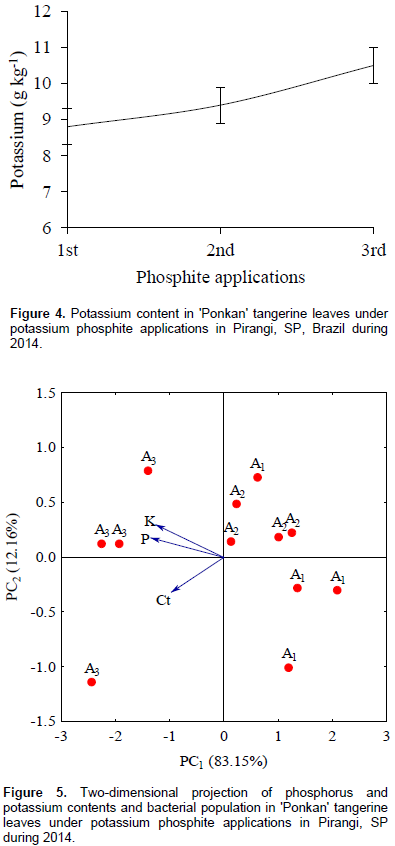ABSTRACT
The objective of this work was to evaluate the population variation dynamics of Candidatus Liberibacter spp. under phosphite applications. The 'Ponkan' tangerines (Citrus reticulata Blanco cv. Ponkan) with symptoms and a high degree of huanglongbing (HLB) severity were used for the test. 'Ponkan' tangerine plants were treated with potassium phosphite leaf applications at a dose of 2.5 L ha-1. Applications frequency was intervals of 25 days with a total of two applications. There was variation in bacterium Candidatus Liberibacter spp. population, depending on the application of phosphite. Phosphites have an indirect action on pathogens control, stimulating the formation of phytoalexins, a natural self-defense substance of plants. Indirect effects of these products were reported in citrus seedlings presenting symptoms of phosphorus deficiency, which when treated with foliar applications of potassium phosphite overcame these symptoms, restoring plant growth. Candidatus Liberibacter spp. population in 'Ponkan' (Citrus reticulata Blanco cv. Ponkan) leaves was reduced and the phosphorus and potassium contents increased with 2.5 L ha-1 of potassium phosphite by means of leaf application.
Key words: Citrus reticulata, leaf nutrition, huanglongbing, phosphorus, potassium.
Citrus crops are an important activity worldwide with special relevance for Brazilian economy. Citrus were introduced in Brazil by the first colonizing expeditions, probably in Brazilian State of Bahia. Citrus crop expansion is attributed to the emergence of new varieties and to the development of cultivars more adapted to cultivated ecosystems (Lopes et al., 2011). Brazil is the largest world producer of citrus plants and the largest exporter of sweet orange juice, which is the main product of the agro-industrial complex of Brazilian citrus growing sector. Citrus crops are distributed in all regions of Brazil, but with a notable concentration in the Southeast region, especially in São Paulo State, whose orchards are mainly based on sweet orange trees, followed by tangerines and acid lime trees (Cunha Sobrinho et al., 2013). Based on the above, it is important to alert that citrus activity is threatened by the occurrence of the most destructive disease in the world, which is pointed out as the protagonist of the decline of the world citrus cultivation. This disease is known as greening (huanglongbing, HLB), caused by the bacterial pathogen Candidatus. The long asymptomatic phase of this disease consists of an obstacle in the decision-making process for strategies to control the pathogen (Aksenov et al., 2014).
Among the main damages caused by huanglongbing disease irregular leaf yellowing, fruit drop and deformity, as well seed abortion and significant reductions in fruits qualitative aspects, such as increased acidity and reduction of soluble solids content can be observed (Choi et al., 2013). In this sense, Pourreza et al. (2014) reported that such problems can have a significant influence on the quality of the raw material supplied to the citrus industry, reflecting directly on the economic sustainability of the productive and industrial chain. This scenario denotes the importance of search for alternatives for controlling or reducing this disease by management of the vector Diaphorina citri Kuwayama (Hemiptera: Liviidae) or reduction and eliminating the bacteria. In this perspective, the use of phosphite may be a viable alternative, especially because the action of phosphite has been reported many times against different pathogens of the most varied cultivated plants (Dianese and Blum, 2010). These compounds are not phytotoxic and have high fungicidal activity, and can act directly by inhibiting the development of the pathogens, also indirectly activating the host plant defence system (Costa et al., 2014). The objective of this work was to evaluate Candidatus Liberibacter spp. population dynamics under phosphite application via the leaves in 'Ponkan' (Citrus reticulata Blanco cv. Ponkan) to develop a strategy to reduce damages caused by huanglongbing on citrus plants.
Experimental area
The experiment was carried out from April to May 2014, in an orchard, in the municipality of Pirangi (Sao Paulo State, Brazil) (21°5' 28" S, 48° 39' 20" W), at 511 m altitude. Temperature, relative humidity, solar radiation and rainfall were obtained with the objective of characterizing climatic conditions during the period the research was conducted (Figure 1).'Ponkan' plants (Citrus reticulate Blanco cv. Ponkan) with symptoms and a high severity degree of huanglongbing disease were used for the experimental test. First, we found twelve plants with characteristics of disease; thereafter, leaves from symptomatic branches were collected to confirm the presence of the bacterium Candidatus Liberibacter spp. These branches were evaluated using a quantitative analysis of polymerase chain reaction (qPCR), and the branch was reserved for subsequent foliar biomass collections (Wang et al., 2006).

Treatments application
The plants were treated with foliar applications of potassium phosphite at a dose of 2.5 L ha-1. Two applications occurred (each 25-day intervals) using a gasoline and oil (two-stroke) coastal farm sprayer, with a capacity of 10 L of mixture and horizontal of 14.5 m action radius. The application of mixture was on the lower part of the leaves with time of two minutes of application for each plant. This time was previously calculated for complete coverage of plant top.
Bacterial population
Twenty-five days after treatment and first collection of leaves, a new collection of plant material and new treatment was performed, and this new collection was performed after another 25 days. The collected material was sent to Sylvio Moreira Citrus Center in Cordeirópolis, State of São Paulo, to perform qPCR (Wang et al., 2006) to monitor bacterium population variation dynamics by means of Ct (Cycle Threshold) value, where Cts <29 denote positive reaction with expressive amount of nucleic acid (NA) of the target bacterium. Cts between 30 and 37 indicate moderate amounts of NA; Cts between 38 and 40 characterize minimal qPRC reactions denoting minimal NA amounts of the target bacterium in the sample.
Phosphorus and potassium contents
Ten leaves of the total collected in each evaluation were separated, conducted in a forced air circulation oven, and maintained at temperature of 65°C until reaching a constant mass. Subsequently, dried leaves were pre-processed manually in a sterile container and conducted to a grinding mill to obtain a homogeneous sample. The samples were sent to Laboratory of the Department of Soils and Fertilizers of the Paulista State University, Campus of Jaboticabal, S.P., Brazil, to carry out the analyzes according to the method established by Bataglia et al. (1983). For determining macronutrients, such phosphorus (P) and potassium (K), nitroperchloric digestion was used. These nutrients are part of potassium phosphite nutritional composition and were evaluated to confirm their absorption by the plant and correlation with the bacterial population.
Statistical analysis
The data obtained from response variables were submitted to analysis of variance (p<0.5). The means of each evaluation were compared by Tukey test (Barbosa and Maldonado Jr, 2015). The correlation between the bacterial population and phosphorus and potassium contents was investigated by means of Principal Component Analysis (PCA). For this, the data were standardized with means zero and unit variance (Hair et al., 2009).
A significant effect of the potassium phosphite applications on bacterial (Ct), phosphorus (P) and potassium (K) content in 'Ponkan' tangerine leaves is shown in Table 1. According to the results, there was variation in the population of the bacterium Candidatus Liberibacter spp. according to phosphite application. At the time of the first evaluation a Ct average value of 18.4±1.2 was found, indicating a high concentration of bacterium nucleic acids in the sample. In a new evaluation, after 25 days of treatment, the Ct mean value (18.3±07) remained stable. In the third evaluation, there was an increase of 14.8% in the value of Ct (21.6±2.2) when compared to the value observed in the first evaluation, and an increase of 15.3% in relation to the value of Ct verified in the second evaluation (Figure 2). 'Ponkan' tangerine leaves had a phosphorus content of 1.63 ± 0.10 g kg-1 in the first application of potassium phosphite on dose of 2.5 L ha-1. Those value increased up 1.73±0.11 g kg-1 in the second application after 25 days, although the difference between the contents of the first and second application was not significant, varying in 5.8%.


In the third application, there was a significant increase in P content which reached 2.13±0.10 g kg-1, representing a percentage gain of 23.5 and 18.8% in relation to the first and second applications, respectively (Figure 3). There was no significant difference in the potassium content of 'Ponkan' leaves in the first (8.8±0.78 g kg-1) and second applications (9.4±0.20 g kg-1), and percentage change of 6.4% was recorded. On the other hand, the contents of this nutrient increased by 10.5% with the third potassium phosphite application, reaching 10.5±0.15 g kg-1 (Figure 4). By means of principal component analysis, it was verified that the three original variables (Ct, P and K) are in the same dimension (CP1) with 83.15% of representativeness of total variance, which indicates the existence of an expressive correlation between these variables and the first main component. In fact, for the bacterial population, represented by Ct, a high correlation was verified (r = 0.86); and also to phosphorus (r = 0.94) and potassium contents, which had a correlation coefficient of r = 0.93 (Figure 5).


Phosphites have indirect action on pathogens control, stimulating phytoalexins production, a natural substance of self-defence of plants (Dercks and Creasy, 1989). The indirect effects of these products were reported by Lovatt (1990) who observed that citrus seedlings presenting symptoms of phosphorus deficiency, treated with foliar applications of potassium phosphite, exceeded these symptoms, restoring plant growth. Foliar applications of phosphite during pre-flourishing in 'Valencia' orange plants increased flower numbers, productivity and soluble solids content in fruits (Albrigo, 1997). Stansly et al. (2013) evaluated an orchard for four years with a significant contribution in the plant production when the foliar program was employed, which is most commonly adopted by farmers in Florida together with the intensive control of the vector. Several studies show differences in the improvements provided by the phosphite application. In fact, Gottwald et al. (2012), working with nutritional treatments containing potassium phosphite, did not observe effect of the nutritional treatments on the bacterium Candidatus Liberibacter spp. when compared to the control treatment in citrus plants. Ratifying this information, Johnson et al. (2013) also showed that the bacterial population in plants that received the nutritional management was similar to those that received the traditional nutrition.
It is important to note that in this research, there occurred population dynamics variation of Candidatus Liberibacter spp., Ct values that presented average of close to 20.0. Ct values that were close to this order are often found in leaves diagnosed with HLB in Florida (USA), and the range of 18.0 <Ct <30.0 is more common for more than 90% of the samples analyzed (McCollum et al., 2013). Therefore, we may infer that new researches with greater number of applications and evaluations are preponderant for better elucidation of the population dynamics of the bacterium in citrus plants. In this study, the increases in P levels recorded are due to the supply of this nutrient via foliar and possible residual effect in the soil, as well as consequent root absorption, providing plants greater capacity in absorption and distribution of the nutrient, as far as new applications are applied (Boaretto et al., 2003). Increasing P is so important, because this nutrient is an essential cellular constituent for nucleic acids, phosphoproteins, phospholipids and ATP synthesis (Hammond and White, 2008). Increases of P contents in citrus were reported by Zhao et al. (2013) that verified the reestablishment of P levels in plants with severe HLB symptoms under foliar phosphorus applications. In a complementary sense, successive applications can be adopted by virtue of mobility and consequent translocation to plant organs where it will be used (Taiz and Zeiger, 2013).
Potassium acts as a regulator of the cellular osmotic potential, besides acting as an enzymatic activator on photosynthetic process and cellular respiration. Generally, due to its easy mobility in the plant, the nutrient is translocated to younger leaves, which justifies its foliar supplementation because part of this nutrient is compromised in older leaves as a result of disease severity. Increasing K content may also reflect improvements in the production quality, since this element influences the size, thickness of the bark, acidity and soluble solids content in fruits (Mattos Jr. et al., 2004; Marini et al., 2005; Taiz and Zeiger, 2013). Potassium supplementation via foliar and its consequent increase in leaves is benefical for the plant, even under infection caused by Candidatus Liberibacter spp., because potassium is directly linked to stomatic movements, especially in the regulation and turgidity maintenance of guard cells, in a way that stoma opening depends on water absorption by these cells. This process is possible starting from K+ ions accumulation; a fact that contribute to increased osmotic potential and to favour water entering in stomatal cells, facilitating stomatal orifice opening (Brodribb and Holbrook, 2003; Chaerle et al., 2005; Lemos et al., 2012; Morgan et al., 2016).
Candidatus Liberibacter spp. population in leaves of 'Ponkan' tangerine (Citrus reticulata Blanco cv. Ponkan) was reduced and phosphorus and potassium contents increased with application of 2.5 L ha-1 of potassium phosphite on leaves. Potassium phosphite is an alternative for reducing the bacterial population in orchards infected by huanglongbing. However, the Ministry of Agriculture, Livestock and Supply (Map) published in the Official Gazette of the Union, normative instruction obliging citrus farmers throughout the country to eradicate plants with symptoms of huanglongbing.
The authors have not declared any conflict of interests.
Authors thank National Council of Scientific and Technological Development - CNPq and Coordination of Improvement of Higher Level Personnel - CAPES for granting a PhD scholarship to the first author; To the Graduate Program in Agronomy (Plant Production) of the Paulista State University - UNESP; and KeyPlex Company.
REFERENCES
|
Aksenov AA, Pasamontes A, Peirano DJ, Zhao W, Dandekar AM, Fiehn O, Ehsani R, Davis CE (2014). Detection of huanglongbing disease using differential mobility spectrometry. Anal. Chem. 86:2481-2488.
Crossref
|
|
|
|
Albrigo LG (1997). Foliar application of major elements for flowering and fruit set. Indian River Citros Seminar, 50th Anniversary.
|
|
|
|
Barbosa JC, Maldonado JW (2015). Experimentação agronômica & agroestat - sistema para análises estatísticas de ensaios agronômicos. Fune P 396.
|
|
|
|
Bataglia OC, Furlani AMC, Teixeira JPF, Furlani PR, Gallo JR (1983). Método de análise química de plantas. Technical Bulletin, Agronomic Institute, Campinas, 78 p.
|
|
|
|
Boaretto AE, Muraoka T, Boaretto RM (2003). Absorption and translocation of micronutrients applied to orange leaves. Laranja 24:177-197.
|
|
|
|
Brodribb TJ, Holbrook NM (2003). Stomatal closure during leaf dehydration. correlation with other leaf physiological traits. Plant Physiol. 132:2166-2173.
Crossref
|
|
|
|
Chaerle L, Saibo N, Straenten DVD (2005). Tuning the pores: towards engineering plants for improves water use efficiency. Trends in Biotechnol. 23:308-315.
Crossref
|
|
|
|
Choi D, Lee WS, Ehsani R (2013). Detecting and counting citrus fruit on the ground using machine vision. ASABE Paper No. 131591603. St. Joseph, Mich.: ASABE. 6 p.
|
|
|
|
Costa BHG, Resende MLV, Ribeiro JPM, Mathioni SM, Pádua MA, Silva JMB (2014). Suppression of rust and brown eye spot diseases on coffee by phosphites and by-products of coffee and citrus industries. J. Phytopathol. 1:1-8.
Crossref
|
|
|
|
Cunha SAP, Magalhães AFJ, Silva SAS, Passos OS, Soares FWS (2013). Cultura dos citros, Brazilian Agricultural Research Corporation, Embrapa Mandioca and Fruticulture, Ministry of Agriculture, Livestock and Supply. Embrapa, Brasília, 1.
|
|
|
|
Dercks W, Creasy LL (1989). Influence of fosetyl – Al on phytoalexin accumulation in the Plasmopara viticola-grapevine interaction. Physiol. Mol. Plant Pathol. 34:203-213.
Crossref
|
|
|
|
Dianese AC, Blum LEB (2010). Uso de fosfitos no manejo de doenças fúngicas de fruteiras e soja. Brasília: EMBRAPA, 29 p.
|
|
|
|
Gottwald TR, Graham JH, Irey MS, McCollum TG, Wood BW (2012). Inconsequential effect of nutritional treatments on huanglongbing control, fruit quality, bacterial titer and disease progress. Crop prot. 36:73-82.
Crossref
|
|
|
|
Hair FJ, Black WC, Babin BJ, Anderson RE, Tatham, Ronald L (2009). Análise multivariada de dados. Tradução Adonai Schlup Sant'Anna. 6. ed., Porto Alegre, Bookman.
|
|
|
|
Hammond JP, White PJ (2008). Sucrose transport in the phloem: integrating root responses to phosphorus starvation. J. Exp. Bot.59:93-109.
Crossref
|
|
|
|
Johnson EG, Irey MS, Gast T, Bright DB, Graham JH (2013). Evaluation of enhanced nutritional programs for mitigating HLB damage. In: 3rd International Conference on Huanglongbing. 2013 Orlando. Proceedings... IRCHB III, 114 p.
|
|
|
|
Lemos LMC, Siqueira DL, Salomão LCC, Cecon PR, Lemos JP (2012). Características físico-químicas da laranja-pera em função da posição da copa. Braz. J. Frut. 34:1091-1097.
Crossref
|
|
|
|
Lopes JMS, Déo TFG, Andrade BJM, Giroto M, Felipe ALS, Junior CEI, Bueno CEMS, Silva TF, Lima FCC (2011). Importância econômica dos citros no Brasil. Electron. J. Agron. 10:20.
|
|
|
|
Lovatt CJ (1990). A definitive test to determine whether phosphite fertilization can replace phosphate fertilization to supply P in the metabolism of 'Hass' on 'Duke 7'. Calif. Avoc. Soc. Yearb. 74:61-64.
|
|
|
|
Marini FS, Marinho CS, Muniz, RA, Carvalho AJC, Monnerat PHM (2005). Doses de sulfato de magnésio em substrato orgânico sobre o crescimento e nutrição de porta-enxertos cítricos. Laranja, 26:135-149.
|
|
|
|
Mattos JRD, Quaggio JA, Cantarella H, Carvalho SA (2004). Modelos de resposta do tangor Murcott à fertilização com N, P e K. Braz. J. Frut. 26:164-167.
Crossref
|
|
|
|
McCollum G, Hilf M, Irey M (2013). Relationship between Ct values, HLB symptoms and CLas titer. In: 3rd International Conference on Huanglongbing. 2013 Orlando. Proceedings... IRCHB III, 18.
|
|
|
|
Morgan KT, Rouse RE, Ebel RC (2016). Foliar applications of essential nutrients on growth and yield of 'Valencia' sweet orange infected with huanglongbing. Hort. Sci. 51:1482-1493.
Crossref
|
|
|
|
Pourreza A, Lee WS, Raveh E, Ehsani R, Etxeberria E (2014). Citrus huanglongbing detection using narrow-band imaging and polarized illumination. Amer. Soc. Agric. Biol. Eng. 57:259-272.
|
|
|
|
Stansly P, Arevalo A, Qureshi Q, Jones MM, Hendricks K, Roberts PD, Roka FM (2013). Vector control and foliar nutrition for management of huanglongbing in Florida Citrus. In: 3rd International Conference on Huanglongbing. 2013 Orlando. Proceedings... IRCHB III, 113.
|
|
|
|
Taiz L, Zeiger E (2013). Fisiologia vegetal. 4a ed. Trans. Eliane Romanato Santarém et al. Porto Alegre: Artmed, 848.
|
|
|
|
Wang Z, Yin Y, Hu H, Yuan Q, Peng G, Xia Y (2006). Development and application of molecular-based diagnosis for 'Candidatus Liberibacter asiaticus', the causal pathogen of citrus huanglongbing. Plant Pathol. 55:630-638.
Crossref
|
|
|
|
Zhao H, Sun R, Albrecht U, Padmanabhan C, Wang A, Coffey MD, Girke T, Wang Z, Close TJ, Roose M, Yokomi RK, Folimonova S, Vidalakis G, Rouse R, Bowman KD, Jin H (2013). Small RNA profiling reveals phosphorus deficiency as a contributing factor in symptom expression for citrus huanglongbing disease. Mol. Plant. 6:301-310.
Crossref
|